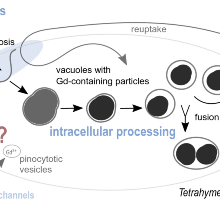J. Kohl, M. Schweikert, N. Klaas and M.‑L. Lemloh
Scientific Reports, 13, 5650, 2023
doi: 10.1038/s41598-023-32596-3
Abstract: ''Ciliates are abundant unicellular organisms capable of resisting high concentrations of metal ions in the environment caused by various anthropogenic activities. Understanding the cellular pathways involved in resistance to and detoxification of elements is required to predict the impact of ciliates on environmental element cycles. Here, we investigated the so far unknown process of tolerance, cellular uptake and bioaccumulation of the emerging rare earth element gadolinium (Gd) in the common ciliate Tetrahymena pyriformis. Gd treatment results in the intracellular formation and excretion of biogenic Gd-containing particles. This cellular process effectively removes dissolved Gd from the organic growth medium by 53.37% within 72 h. Based on light and electron microscopic observations, we postulate a detoxification pathway: Cells take up toxic Gd3+ ions from the medium by endocytosis, process them into stable Gd-containing particles within food vacuoles, and exocytose them. Stable biogenic particles can be isolated, which are relatively homogeneous and have a diameter of about 3 µm. They consist of the elements Gd, C, O, P, Na, Mg, K, and Ca. These findings broaden the view of metal ion accumulation by protists and are of relevance to understand environmental elemental cycles and may inspire approaches for metal recovery or bioremediation.''


